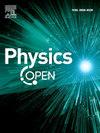Gravitational lensing and missing mass
Q2 Physics and Astronomy
引用次数: 0
Abstract
The mass of an astrophysical object can be estimated by the amount of gravitational lensing of another object that it causes. To arrive at the estimation however, one assumes the validity of the inverse square law of gravity, or equivalently an attractive potential. We show that the above, augmented by a logarithmic potential at galactic length scales, proposed earlier to explain the flat galaxy rotation curves, predicts a larger deflection angle for a given mass. In other words, the true mass of the object is less than its estimated value. This may diminish the importance and role of dark matter in explaining various observations.
引力透镜效应和质量缺失
一个天体物理物体的质量可以通过它引起的另一个物体的引力透镜量来估计。然而,为了得出这个估计,我们假设重力平方反比定律是有效的,或者相当于一个有吸引力的1/r势。我们表明,在前面提出的用来解释平坦星系旋转曲线的星系长度尺度的对数势的基础上,上述公式预测了给定质量的更大的偏转角。换句话说,物体的真实质量小于它的估计值。这可能会降低暗物质在解释各种观测结果中的重要性和作用。
本文章由计算机程序翻译,如有差异,请以英文原文为准。
求助全文
约1分钟内获得全文
求助全文
来源期刊

Physics Open
Physics and Astronomy-Physics and Astronomy (all)
CiteScore
3.20
自引率
0.00%
发文量
19
审稿时长
9 weeks
 求助内容:
求助内容: 应助结果提醒方式:
应助结果提醒方式:


